
Get in the Know about the New National Building Code
Important changes that will affect how developers build houses and condos
Your home is supposed to be a peaceful retreat…until the neighbours make a lot of noise. Noise can be much more concerning for owners of semi-detached homes, condos, or townhouses where sound can easily travel through walls, even if they are built to code. Even Mike Holmes knows this a problem. As an acoustical consultant, I get at least one call a month from condo owners asking if we can come to test noise, or what can be done to minimize noise from their neighbours.
The overall amount that a wall will reduce the sound is commonly called the Sound Transmission Class (STC) and is a single number value to represent how well a wall reduces sound. Generally, the higher the number, the less sound transmitted. Neighbouring units must be separated by a wall, floor or ceiling with a STC rating of 50, but, as we’ll see, this doesn’t mean there won’t be a problem.
The challenge with the current code is that it only considers the wall separating two spaces, yet we know sound does not only travel through the air from one room to another – it travels through the walls, floors, ceilings, windows, ductwork, etc. The STC tests done on a wall in a laboratory do not take these factors into account, so it’s possible to have problems if there are many flanking paths (or if there are shared ducts, or other equipment traversing multiple spaces, or if construction is poor). Something as simple as electrical outlets back to back on a wall can significantly reduce the STC value.

Flanking noise: noise transmitted through wall, ceiling and floor junctions
As an acoustical consultant, when testing, we sometimes find that the partition meets code, but we agree there’s still an issue (typically due to flanking); not what unit owners usually want to hear. One would imagine the condo board would be pleased to hear the construction meets code, but it doesn’t get rid of the complaint nor the fact the sound is usually disturbing. What should be a clear solution turns into murky waters with no one sure of what to do next or who is responsible.
Upcoming proposed changes to the National Building Code (NBC) will eventually change the way builders and architects construct homes. The government created a task group to consider the use of a new rating to address “flanking” noise. This rating is called the Apparent Sound Transmission Class (ASTC), which is a more realistic measure of the actual sound level perceived by occupants, as it includes noise transmitted on all possible paths.
The proposed changes are to the NBC, so it will take time for the Ontario Building Code (OBC) to adopt the same measures. If the NBC adopts the new ASTC rating in 2015, we can expect the OBC to follow suit in time. This is critical because in Ontario, with the Tarion Warranty Program requiring post-construction testing, meeting the proposed ASTC code requirements would mean not just selecting walls based on paper tests, but having to ensure the design and construction meets much higher standards than they do today.

There is a proposal by the National Research Council (NRC)
Canada to adopt Apparent Sound Transmission Class (ASTC).
I believe it’s a move in the right direction, and one that will certainly raise the bar on acoustics and its impact in residential developments. If adopted, I am confident owners will notice a difference and complaints about noise will reduce (but will never go away). The downside will be added responsibility on the design and construction teams (which means the costs will invariably pass to purchasers). But given the degree of complaints people have, this is a cheap price to pay.
If you are a condo developer who feels he/she has a problem, or a builder who wants to learn more, feel free to contact me directly if you would like any further insight at [email protected].
